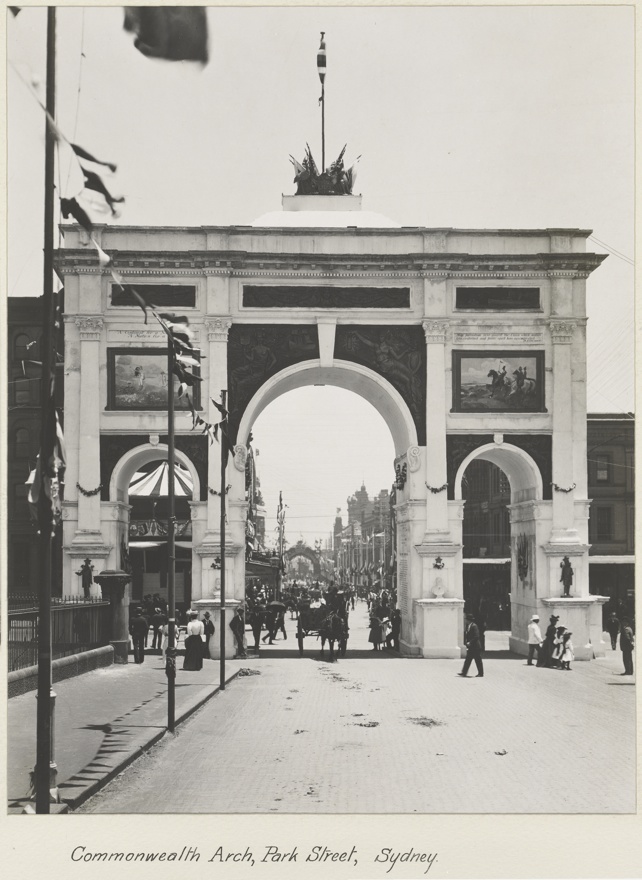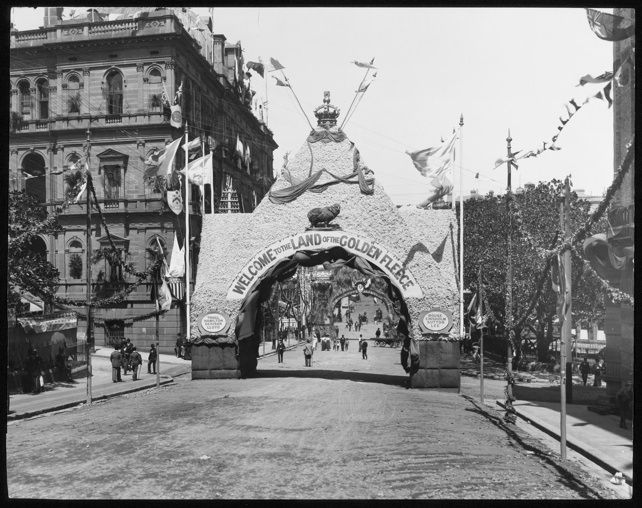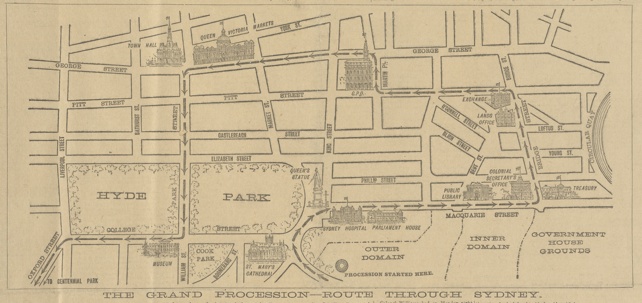Resource Sheet 1
Inauguration of the Commonwealth in Sydney
An historic demonstration
The sanguine people who lined all the five miles and a half of the procession with stands were not disappointed. From start to finish the procession passed through an unbroken avenue of serried ranks of people. They filled all the paths, they swarmed from every parapet, they crammed every window with their happy faces, and then they blackened all the slopes of the wide-spreading Centennial Park. Emphatically, it was a people’s day.
It was also an Imperial day. The motherland sent her troops, splendidly arrayed, to do honour to her Australian kinsmen in their hour of destiny, and she also contributed her dusky warriors from India as an object lesson displaying her sympathy and her power of rule.
The procession
Instead of the moist, rich smell of the Himalayas, which…the teller of Indian tales puts it, the [India Troops] had the pungent scent of the young gum leaves in their nostrils. Further away…the Household Cavalry, the Foot Guards, and Fusiliers were breathing the same new scent instead of the fragrance of the English thorn. The Maori Guards of the Premier of New Zealand cantered past the gorgeous Indian troops, showing the easy colonial seat in the saddle and the simple khaki uniform.
By the Commonwealth arch
The next arch was the Commonwealth arch, of gleaming white adorned with the names of all who have served the cause of united Australia written upon the shining walls in letters of gold. Some of those whose names are written there are dead, others are no longer in the fighting lists of politics but all have deserved well of their country, and it was fitting that their names be recorded on the walls of this arch, which was erected to mark the triumph of their long drawn labours, so that the soldiers of the empire might read them as they passed through.
Passing the Queen’s statue
The Bells of St. Mary’s Cathedral were ringing gaily as the head of the immense column, nearly three miles in length, moved out of the main entrance gates of the Domain, and swung round to the right, so as to pass through the Queen’s square.
The Argus, 2 January 1901.
The Commonwealth arch, Park Street, Sydney 1901

Government Printing Office, State Library of New South Wales.
The Wool arch, Bridge Street, Commonwealth Day Procession, Sydney, 1901

National Library of Australia, nla.pic-an13143006-6.
More arches
"Black diamonds" from Newcastle compose the first arch, which is typical of the great coal industry of New South Wales. A large block of coal has been utilised as a foundation, and the upper portions of the columns and archway are constructed with wire netting lumps of coal.
A wool arch commands mention, because it represents the great National Industry Commonwealth. At the base are bales of wool and columns. The arch consists of scoured fleeces loosely thrown into a wire netted frame. Across the semi circle are painted in gold the words, "Welcome to the land of the golden fleece."
Street decorations
That part of Pitt-street between Bridge and Bond streets has been transformed into a French avenue. The French arch bears on its supporting pillars the coats of arms of Paris, Lyons, Marseilles, and Bordeax. In its centre is displayed the coat of arms of the Republic, surrounded by the Australian and French Flags.
The American arch and a mazy arcade of stars and stripes take up the running from the junction of Hunter and Pitt streets. “America hails the new-born nation” on one side, and on the other the "United States of America greet United Australia".
The swearing-in of the governor-general
Lord Hopetoun, wearing the Order of the Thistle, a gorgeous uniform, and several distinguished stars, walked with a large stick. Archbishop Smith, the Primate, in the robes of his high office, officiated.
The crowd stood with bared heads. With deep intonation Archbishop Smith then read the prayers for the Commonwealth. Then followed the prayer for the Governor-General, and the Lord’s Prayer.
Lord Hopetoun’s communication from Her Majesty was read with a firm, unhesitating voice. Lord Hopetoun declared, among ringing cheers:
"I, John Adrian Lewis, Earl of Hopetoun, solemnly swear that I will truly and faithfully serve the Queen, so help me God."
The supreme moment had arrived—that moment for which Federalists for half a century prayed and fought, guns boomed forth a salute proclaiming to the world, as Lord Hopetoun signed his name, that he had assumed his official duties and was invested with all the powers conferred upon the Queen’s representative by the constitution.
The West Australian, 2 January 1901.
Centennial Park, Sydney, Commonwealth Day 1 January 1901

Swearing in ceremony, Centennial Park, Sydney, Commonwealth Celebrations, 1901, National Library of Australia, nla.pic-an13117410-1.
The grand procession route through Sydney

The Argus, 2 January 1901.
God Save the Queen
God save our gracious Queen!
Long live our noble Queen!
God save the Queen!
Send her victorious,
Happy and glorious,
Long to reign over us,
God save the Queen.
Thy choicest gifts in store
On her be pleased to pour,
Long may she reign.
May she defend our laws,
And ever give us cause,
To sing with heart and voice,
God save the Queen.
Advance Australia Fair
by Peter Dodds McCormick
Australia’s sons let us rejoice,
For we are young and free;
We’ve golden soil and wealth for toil,
Our home is girt by sea;
Our land abounds in Nature’s gifts
Of beauty rich and rare;
In hist’ry’s page, let ev’ry stage
Advance Australia fair.
In joyful strains then let us sing,
Advance Australia fair.
When gallant Cook from Albion sailed,
To trace wide oceans o’er,
True British courage bore him on,
Til he landed on our shore.
Then here he raised Old England’s flag,
The standard of the brave;
“With all her faults we love her still”
“Britannia rules the wave.”
In joyful strains then let us sing
Advance Australia fair.
Beneath our radiant Southern Cross,
We’ll toil with hearts and hands;
To make our youthful Commonwealth
Renowned of all the lands;
For loyal sons beyond the seas
We’ve boundless plains to share;
With courage let us all combine
To advance Australia fair.
In joyful strains then let us sing
Advance Australia fair!
Should foreign foe e’er sight our coast,
Or dare a foot to land,
We’ll rouse to arms like sires of yore,
To guard our native strand;
Britannia then shall surely know,
Though oceans roll between,
Her sons in fair Australia’s land
Still keep their courage green.
In joyful strains then let us sing
Advance Australia fair.